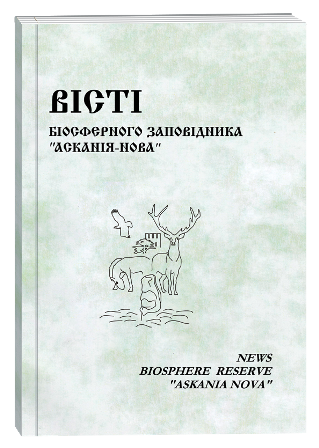НАСАДЖЕННЯ ПІВДЕННО-ЗАХІДНОЇ ЧАСТИНИ ДЕНДРОЛОГІЧНОГО ПАРКУ "АСКАНІЯ-НОВА": АКТУАЛЬНИЙ СТАН ТА ЗАХОДИ З ОПТИМІЗАЦІЇ
DOI:
https://doi.org/10.53904/1682-2374/2022-24/14Ключові слова:
Деревостани, таксономічна структура, кількісний склад, відновлення насадженьАнотація
Охарактеризовано таксономічну та фітоценотичну структуру насаджень південно-західної частини старого парку, проведено ретроспективний аналіз її змін порівняно із 2003 роком. Насадження складають 40 видів і 1 форму деревних рослин, у тому числі 5 видів голонасінних. Домінують 4 види листяних, абсолютну перевагу має Celtis occidentalis L. (1505 особин), Fraxinus excelsior L. представлений 426 особинами, Robinia pseudoacacia L. та Ulmus carpinifolia Rup. & Suck. – 257 та 247 особинами, Styphnolobium japonicum (L.) Schott. –81 особина. Частка 5 видів, у тому числі Quercus robur L. та Gleditsia triacanthos L., становить від 20 до 30 особин, ще 6-ти – від 10 до 18. Інші види представлені одиничними чи кількома особинами. Таксономічний склад збільшився на 8 видів за рахунок поширення із сусідніх масивів та проведеного відновлення ландшафтно-пейзажних композицій. Збільшилася група крупномірів (з діаметром стовбура від 40 см): до неї перейшли дерева Fraxinus excelsior – 34, Robinia pseudoacacia – 7, Gleditsia triacanthos – 4, Styphnolobium japonicum – 3, Quercus robur пірамідальної форми – 1; значно побільшало таких небажаного для парку Celtis occidentalis – 19. Також додалося дерев з діаметрами стовбурів від 61–65 см до 92 см та вперше зареєстровано дерева Fraxinus excelsior з діаметром 92–102 см і Quercus robur – 122 см. Кількісний склад є достатньо стабільним (2792 особини проти 2839 у 2003 році), втім, звертає на себе увагу значне збільшення чисельності дорослих особин, підросту та масового самосіву Celtis occidentalis. Зміни у співвідношенні кількості дерев паркоутворюючих і небажаних порід вказують на необхідність проведення заходів з відновлення насаджень, серед яких нагальними є вилучення інsвазійних видів Ailanthus altissima (Mill.) Swin. та Acer negundo L.; вилучення самосіву Celtis occidentalis та регулювання чисельності його жердняка; сприяння поновленню Fraxinus excelsior, Styphnolobium japonicum, Acer platanoides L. та A. Campestre L.; введення на південному та північно-західному узліссях, у "вікнах" саджанців Quercus robur.
Посилання
Інтродукція нових та рідкісних видів декоративних рослин для збагачення культивованої флори і використання в паркобудівництві та озелененні на півдні степової зони України" : звіт про науково-дослідну роботу за 2001–2005 рр. (заключний). № держреєстрації 0101U000782. Біосферний заповідник "Асканія-Нова" : Асканія-Нова, 2006. С. 43–50.
Розробити наукові основи збереження, оптимізації та раціонального використання фітогенофонду дендропарку "Асканія-Нова" : звіт про науково-дослідну роботу за 2016–2020 рр. (остаточний). № держреєстрації 0116U003202. Біосферний заповідник "Асканія-Нова" : Асканія-Нова, 2020. С. 9.
Комаров В. Л. Учение о виде у растений. Страница из истории биологии. Москва – Ленинград : Изд-во АН СССР, 1944. 244 с.
Крюссман Г. Хвойные породы. Пер. с нем. Н. Н. Непомнящего / Под ред. канд. биол. наук Н.Б. Гроздовой. Москва : Лесная пром-ть, 1986. 256 с.
Rehder A. Manual of cultivated trees and shrubs hardy in North America. New York : The Macmillan Company, 1949. 996 р.







